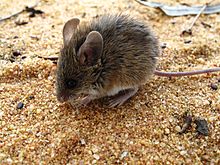Pilliga mouse
| Pilliga mouse | |
|---|---|

| |
| Scientific classification | |
| Domain: | Eukaryota |
| Kingdom: | Animalia |
| Phylum: | Chordata |
| Class: | Mammalia |
| Order: | Rodentia |
| Family: | Muridae |
| Genus: | Pseudomys |
| Species: | P. pilligaensis
|
| Binomial name | |
| Pseudomys pilligaensis Fox & Briscoe, 1980
| |
Pseudomys pilligaensis,commonly known as thePilliga mouseorpoolkoo,is a species ofrodentin the familyMuridae.Its distribution comprises thePilliga forestregion ofNew South Wales,Australia, specimens have also been trapped in theWarrumbungle National ParkandWeetalibah Nature Reserve.Its conservation status is currently listed as "Data Deficient" due to unresolved questions on its taxonomic status.
Description
[edit]P. pilligaensisis a small brown mouse with grey-brown upper parts, the head and back greyer, grading through russet flanks to white underparts. The feet are pale pink on top with white hairs. The head-body length is 73–80 millimetres (3–3 in) and the tail about the same length or slightly less. The tail is pale pink with a distinct brown line along the top and a small tuft of darker hairs on the end. The ear length is 15–18 millimetres (0.6–0.7 in) and the weight of the animal is 10–14 grams (0.4–0.5 oz).[2][3]

Taxonomy
[edit]The Pilliga mouse was first formally described in 1980 by Barry Fox and David Briscoe. They distinguished it from the similar speciesP. novohollandiae,P. delicatulusandP. hermannsburgensison the basis of characters such as skull size and shape and the ratio between tail and head/body length.[4]More recent work has suggested that it is a southern population of the delicate mousePseudomys delicatulus.[5][6]Another suggestion is that it is it a hybrid betweenPseudomys delicatulusand the New Holland mouse (Pseudomys novaehollandiae).[7]
Distribution and habitat
[edit]P. pilligaensiswas described as having a restricted distribution in thePilliga forestin centralNew South Wales,initially collected from only four sites within the Pilliga "scrub", none more than 50 km apart.[4]More recent work has shown the Pilliga Mouse is found across central and eastern sections of the Pilliga forest. However, after a bushfire in January 2013 which burned about 80% of the Warrumbungle National Park, a specimen was collected in that park. Pilliga mouse populations increase rapidly in size after fire[8]and rain.[9]Recent research indicates that preferred habitat for this species includes shrubby woodlands and heathlands, particularly where BroombushMelaleuca uncinataand BloodwoodCorymbia trachyphloiaoccurs.[8][10]The mouse is nocturnal and lives in burrows.[8]
Conservation
[edit]As of January 2015, the Pilliga mouse is currently listed by the IUCN as "Data Deficient" because of the uncertainty of its taxonomic status. If further research indicated that the Pilliga mouse is a separate species, its status would be determined as "Endangered".[1]Threats to the population in the Pilliga include exploration and infrastructure construction relating to coal seam gas, as well as habitat loss through forestry, predation by the introduced cat and fox, and competition from the house mouse.[2]
References
[edit]- ^abBurbidge, A.A.; Woinarski, J. (2016)."Pseudomys pilligaensis".IUCN Red List of Threatened Species.2016:e.T18555A22398339.doi:10.2305/IUCN.UK.2016-1.RLTS.T18555A22398339.en.Retrieved17 November2021.
- ^ab"Pseudomys pilligaensis— Pilliga Mouse, Poolkoo ".Species Profile and Threats Database.Australian Government Department of the Environment.Retrieved2 June2015.
- ^Menkhorst, Peter & Knight, Frank (2001).A field guide to the mammals of Australia.South Melbourne, Australia: Oxford University Press. pp. 194–195.ISBN019550870X.
- ^abFox, Barry & Briscoe, David (May 1980). "Pseudomys pilligaensis: A new species of murid rodent from the Pilliga scrub, northern New South Wales".Australian Mammalogy.3(2): 109–126.doi:10.1071/AM80013.S2CID254722138.
- ^Strahan, Ronald (2008). Dyck, Steve Van (ed.).The mammals of Australia(3rd ed.). Sydney: Reed New Holland. p. 880.ISBN9781877069253.
- ^Woinarski, John C.Z.; Burbidge, Andrew A. & Harrison, Peter L. (2014).The action plan for Australian mammals 2012.CSIRO.ISBN9780643108738.
- ^"Piliga Mouse - profile".N.S.W. Government Office of Environment and Heritage.Retrieved2 June2015.
- ^abcPaull, David C. (2009)."Habitat and post-fire selection of the Pilliga Mouse Pseudomys pilligaensis in Pilliga East State Forest".Pacific Conservation Biology.15(4): 254–267.doi:10.1071/PC090254.
- ^Tokushima, Hideyuki; Green, Stuart W. & Jarman, Peter J. (2009)."Ecology of the rare but irruptive Pilliga mouse (Pseudomys pilligaensis). I. Population fluctuation and breeding season".Australian Journal of Zoology.56(6): 363–373.doi:10.1071/ZO08042.
- ^Paull, David; Milledge, David; Spark, Phil; Townley, Sally & Taylor, Kevin (2014)."Identification of important habitat for the Pilliga MousePseudomys pilligaensis".Australian Zoologist.37(1): 15–22.doi:10.7882/AZ.2013.010.

